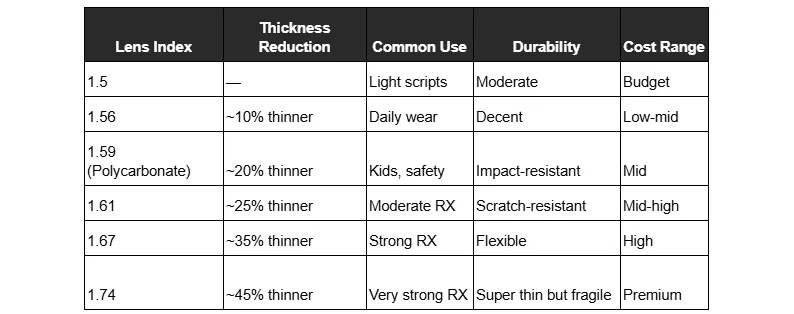- VOLUME 69: What’s the Best Lens Index for Prescription Glass Lenses?
VOLUME 69: What’s the Best Lens Index for Prescription Glass Lenses?
Monday, 4 August 2025Getting your prescription sorted is only half the battle—choosing the best lens index plays a big role in how your glasses feel, function, and sit on your face. From eye strain and bulk to price and aesthetics, picking the wrong index can leave you second-guessing every time you wear them. Make the right call and you’ll enjoy better clarity, more comfort, and frames that truly suit your everyday life.
This guide will help you weigh up your options clearly—no jargon, no fuss. You’ll get a grip on what lens index means, why it matters, and how to pick the right type based on your script strength, lifestyle and frame choice.
Why does the lens index matter when choosing glasses?
Lens index affects the overall thickness, weight and appearance of your lenses. It refers to how efficiently the lens material bends light. The higher the index, the thinner the lens can be while still correcting your vision.
- Thinner lenses mean less pressure on your nose and ears, which can be a big plus if you're wearing glasses all day.
- Stronger prescriptions in low-index lenses can look chunky, feel heavy and even distort your appearance.
- They often include extras like anti-glare, UV filtering and scratch resistance.
- On the flip side, low-index lenses cost less and are perfectly fine for mild prescriptions.
Getting the index right means you’re not stuck with lenses that feel clunky or look oversized—it’s about finding the right mix of comfort, price and performance.
Are high-index lenses always the better option?
Not always. High-index lenses have their perks, but aren’t the best pick for everyone.
- If your prescription is mild—say, around ±1.00 to ±2.00—standard lenses do the job just fine.
- As your prescription climbs, the need for a higher index becomes more important to keep your lenses light and discreet.
- Without anti-reflective coatings, high-index lenses can reflect more light and reduce clarity.
- Some people say ultra-thin lenses feel fragile, even when they’re technically durable.
- They shine with minimalist frames, but may not be worth the cost if your script is light.
In many cases, the way your frames pair with different lens types matters just as much as the index itself.
Can the wrong lens index affect your vision quality?
It can. Lens index doesn’t just influence thickness—it can affect how clearly you see and how your glasses sit on your face.
- Using a low index with a strong script leads to thick, heavy lenses that put more weight on your nose.
- Heavier lenses can slip down or cause discomfort over long days.
- In some cases, thicker edges can distort your peripheral vision, especially with large frames.
- High-index lenses can have slight chromatic aberration—subtle colour shifts around the edges—but this is minor for most wearers.
- Going for lenses with digital surfacing or custom curves can help minimise these effects.
When making your choice, it’s worth factoring in any extras that support preventing common eye problems, especially if your prescription or lifestyle puts extra strain on your vision.
How do prescription glass lenses vary by index type?
Each lens index offers a different mix of weight, thickness and durability. Here’s a simple comparison:
- Thin doesn’t always mean tough—some ultra-thin lenses scratch or chip more easily.
- High-index lenses often come with clearer optics and better UV defence.
If you spend heaps of time outdoors, it’s smart thinking to choose the ideal tint and index for outdoor use—you’ll get better clarity and protection under the Aussie sun.
Which lens index suits your prescription glass lenses best?
Choosing the lens index depends on your script strength, frame style, and how you use your glasses day-to-day.
- Mild prescriptions (±1.00 to ±2.00): A 1.50 or 1.56 index will do the trick.
- Moderate (±2.25 to ±4.00): Aim for a 1.59 or 1.61 for a great balance of thinness and clarity.
- Strong (±4.25 to ±6.00): A 1.67 index keeps lenses slim without going overboard.
- Very strong (above ±6.00): 1.74 is your go-to for minimal bulk and the sleekest look.
Some frame types work better with thinner lenses, especially light, open designs. To avoid surprises later, focus early on selecting suitable lenses for your eye strength before locking in your frames. It makes a real difference in both fit and clarity.
What should you ask before buying prescription glass lenses?
A bit of prep goes a long way. Ask the right questions upfront, and you’ll steer clear of post-purchase regrets.
- Will this index suit both my prescription and frame choice?
- Are coatings like anti-scratch, UV or blue light filtering already included?
- Will the lenses feel heavy or slip down during wear?
- Is polycarbonate a better choice for sport, safety or active use?
- How does the lens index affect warranty, returns or future upgrades?
These might seem like small details, but they’re the things that make your glasses feel spot-on. A good optician should walk you through your options without pushing upsells. Take a moment to assess your lifestyle and usage—asking smart questions leads to sharper, comfier results.
Final thoughts on choosing the right index for prescription glass lenses
Choosing the right lens index isn’t just about looks or budget—it’s about seeing clearly, wearing comfortably, and feeling confident in your choice. If you're still unsure which way to go, you can always get expert help from Dresden Vision to work out which index suits your lifestyle and prescription best. Their advice can help you land on lenses that feel right from the get-go.

